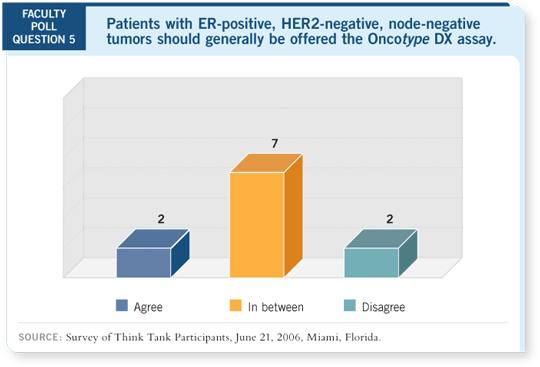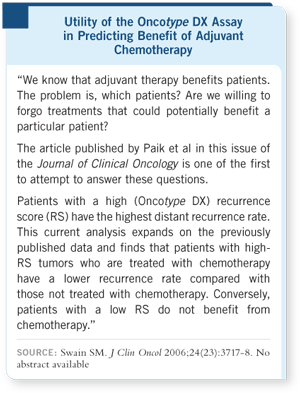

Select Excerpts from the Discussion
CD 1, Tracks 13-14
 DR RAVDIN: Sandy Swain wrote an editorial following publication of the
results from the Oncotype DX assay with the NSABP-B-20 data set entitled
“A Step in the Right Direction” (Swain 2006).
DR RAVDIN: Sandy Swain wrote an editorial following publication of the
results from the Oncotype DX assay with the NSABP-B-20 data set entitled
“A Step in the Right Direction” (Swain 2006).
She estimates that this assay could potentially spare 50,000 women per year
treatment with chemotherapy on the basis of prognosis alone (Swain 2006).
I would agree with her, but we also have ways of doing this on the basis of
tumor size and grade.
She also commented that estrogen receptor measurements by IHC are not
quantitated. So even if you wanted to use some of these other methods, they
might not be as reliable as the Oncotype DX test. Some patients with high ER
also have a high recurrence score. So if you simply used high ER as a correlate
for chemotherapy responsiveness or, in this case, resistance, you would be
fooled sometimes.
 Dr Swain’s conclusion was that the recurrence score appears to be beneficial in predicting which patients
will benefit and which will
not (Swain 2006). However,
the recurrence score is only
the beginning. I believe
we’d all agree that this is a
very useful test, but I hope
it is something that will be
refined.
Dr Swain’s conclusion was that the recurrence score appears to be beneficial in predicting which patients
will benefit and which will
not (Swain 2006). However,
the recurrence score is only
the beginning. I believe
we’d all agree that this is a
very useful test, but I hope
it is something that will be
refined.
If you agree with Sandy
Swain’s editorial, you might
conclude that all patients
with node-negative, ER-positive
disease should be
tested with the Oncotype
DX assay. The major caveat
is that NSABP-B-20 did not
use modern regimens that
we utilize in the clinic today.
The chemotherapy in that
trial was M  F or CMF, and
it was always used in combination
with tamoxifen (Paik
2006), so tamoxifen might
have had confounding effects on the results.
F or CMF, and
it was always used in combination
with tamoxifen (Paik
2006), so tamoxifen might
have had confounding effects on the results.
How much benefit was seen from the chemotherapy in this trial? If you look
at the 10-year results, you see effectively no benefit in the low-risk group. The
high-risk group showed a dramatic benefit — about a two thirds reduction in
the risk of the development of metastatic disease (Paik 2006).
 DR GEYER: I believe the recurrence score helps in counseling a woman about
the importance of chemotherapy for her situation. If she has a high recurrence
score, chemotherapy is the dominant part of her therapy. If she has an intermediate
recurrence score, I believe the main part is the hormonal therapy, but
that’s not to say chemotherapy isn’t helpful.
DR GEYER: I believe the recurrence score helps in counseling a woman about
the importance of chemotherapy for her situation. If she has a high recurrence
score, chemotherapy is the dominant part of her therapy. If she has an intermediate
recurrence score, I believe the main part is the hormonal therapy, but
that’s not to say chemotherapy isn’t helpful.
We need to develop an understanding of the importance of the various
components. The Oncotype DX results provide counseling information about
the risk-to-benefit ratio that is relevent when women run into toxicities, for
example — how far should they persevere through toxicities.
Select publications

